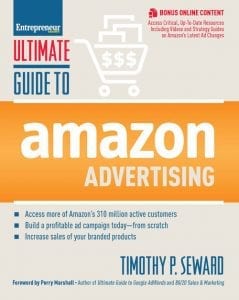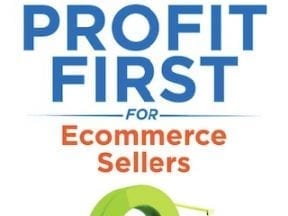Editor’s Note: Timothy Seward is founder and CEO of ROI Revolution, the pioneering ecommerce marketing firm for brands, retailers, and B2B merchants. His book, “Ultimate Guide to Amazon Advertising,” is newly published by Entrepreneur Media. What follows is an excerpt.
In my hometown of Raleigh, North Carolina, summer is always peak concert season. There are so many bands and artists to see. The energy and excitement that comes from hearing your favorite music performed live by the original artist while you’re surrounded by friends and neighbors is almost indescribable.
But for every top performer who is hugely successful at what they do (and rich because of it), there are thousands, perhaps hundreds of thousands, of musicians who are struggling, pounding the pavement, and working gigs at small clubs hoping to hit it big.
The same is true in business generally and brand commerce specifically. For every Apple, Procter & Gamble, Amazon, and Coca-Cola, there are thousands more companies that are just doing OK.
As you consider how best to build your brand on Amazon, think broadly about your game plan for optimal success. Here are a few key strategies to help you focus your efforts on finding even greater success in commerce — whether you’re celebrating your fifth year in business or your 50th.
Key 1: You understand the Mind of the Buyer
You sell products and services where you keenly understand the mind of the buyer. The more you understand the buyer — their needs and desires, what they’re willing to pay good money for, why they buy — the easier it will be to make great decisions. If you don’t know what they want, then survey them until you do.
At ROI Revolution, we’re always asking questions to better serve our clients, and you should do the same. We ask questions like:
- Would you recommend us to your friends and colleagues?
- What about your business keeps you awake at night?
- What was the specific pain you wanted to address just before you hired us?
- What enabled you to eventually trust us?
- What other marketing services do you need or want?
Think of questions to ask customers or potential customers so you can better address their needs and wants.
Key 2: You’re Doing Something You Have Intense Enthusiasm For
Have you ever studied the tour calendar for a major band or artist? Lubbock, Texas; Dallas, Texas; Lafayette, Louisiana; St. Louis, Missouri; Noblesville, Indiana; on and on it goes as they crisscross the country in their tour buses and big rigs. Night after night it’s the same performance, the same songs, again and again and again.
But when your favorite band comes to play, even if it’s the 37th stop of the tour for the artist, for the audience, it’s magic. It’s as if they came to play just for you and your friends. How do they stay fresh?
In two words: intense enthusiasm. A talented artist bemoans the end of the tour. Make sure you’re doing or selling something for which you have, or can develop, an intense enthusiasm for. And if you’ve already created success but lose enthusiasm for your work, the success soon leaves you.
If it’s your brand, or if you are in charge of your brand’s product expansion strategy, develop and market products you truly believe in and are excited about.
Key 3: You Build and Promote Your Own Brand
Virtually every artist starts out by performing covers of other artists’ songs in small clubs. However, name one major band or artist who makes performing other bands’ popular songs their core repertoire. You can’t. Sure, most artists perform some songs by other bands, but it’s not their whole act.
The same rule applies to products. It’s fine if you start off selling other companies’ products but focus on getting to the point where you’re selling your own trademark-protected products (i.e., under your own brand or label).
Don’t Have Your Own Product Brand?
For retailers of products made by other brands, selling on Amazon isn’t as compelling an opportunity. When you sell on Amazon, you’re building their brand (both the manufacturer’s and Amazon’s). Amazon and the brand own the relationship with the customer. And, with lower product margins compared to that of the brand owners, it often isn’t profitable to pay Amazon sellers’ fees and ad click costs.
Unless you realistically have a shot at becoming a major distribution player in your field (e.g., Walmart, Target, PetSmart, etc.) or have products that due to their size, weight, or need for customization cannot get marginalized (or outmaneuvered) by Amazon, you want to manufacture products under your own brand. Even major distribution players do this over time. Walmart, Target, and PetSmart all have their own house brands.
As a retailer, your strategy takes a bit more planning and investment, but it may be the best in the long run anyway. Take a cue from Amazon. Over the past few years, Amazon has launched their own house brands in key categories. Sure, there’s the phenomenally successful Amazon Echo, but Amazon also has a number of lesser-known brands, such as AmazonBasics, Happy Belly, Wickedly Prime, and Presto! This is no small move, and it’s paying off. For example, AmazonBasics batteries reportedly account for one-third of all batteries sold online.
You can have others manufacture your branded products for you, or you can manufacture them yourself. Resist the urge to build your business by only selling someone else’s branded merchandise. If someone else owns the brands you’re selling, Target, Walmart, or Amazon is — or eventually will be — selling them too.
With a new or emerging brand, you’ll have a greater opportunity to get some of those 310 million potential Amazon customers to discover, and then buy, your brand’s products.
Reprinted with permission of Entrepreneur Media, Inc. ©2019 Entrepreneur Media, Inc. All rights reserved.





